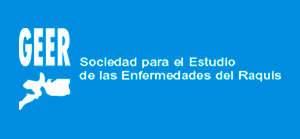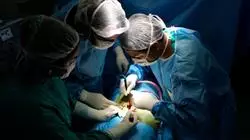University certificate
Scientific endorser

The world's largest faculty of medicine”
Introduction to the Program
This program in Spinal Surgery is one of the most demanded, due to the high percentage of people who suffer from back pathologies"

There is an increasing tendency towards sub-specialization within the medical-surgical specialities. There are so many different systems in the human body that it is difficult to be up to date in the knowledge of a speciality as broad as Spinal Surgery. Hence, the need for a complete and high-quality scientific program to help and guide in this specific and exciting field.
With this Professional master’s degree, the student will have a complete vision of the knowledge of the Pathology of the Vertebral Column. The program will highlight advances in surgical practice that directly affect patients' quality of life and improvement of pain. This information will be transmitted so that the students can have the most up-to date vision possible of the knowledge that exists on the subject. For this purpose, experts in Spinal Surgery from Spain and South America will be collaborating with us.
The Professional master’s degree in Spinal Surgery will teach both the classic and usual practices used in the Specialized Surgery Centers, as well as the surgical techniques that are currently setting trends in this sector. This will allow the student, in addition to broadening their personal knowledge, to be able to apply it with greater confidence and skill in making decisions in their daily clinical practice.
All aspects of the practice of Spinal Surgery, with a global vision of the care of the affected patient, in the most complete Professional master’s degree in the online teaching market"
This Professional master’s degree in Spinal Surgery contains the most complete and up-to-date scientific program on the market. The most important features:
- Theoretical multimedia content throughout the Professional Master's Degree, developed with the latest educational technologies, accessible at all times
- Video lessons on the different pathologies, as well as surgeries will be shown
- Practical workshops in which clinical cases of daily practice are developed, which will help in decision-making, through diagnostic and treatment algorithms
- Practical cases that will serve as self-assessment and will mark the progress of the students’ knowledge
- Online surgical procedures, performed in the daily practice of these advances, live or previously recorded
- Theoretical lessons, via videoconference, with the possibility of participating in a discussion forum to comment and clarify doubts}
- Chats for consultation of doubts about clinical cases with the students participating in the program
- Possibility to interact with the teachers of the Professional Master’s Degree and to solve in a simulated environment, pathologies that arise in their daily practice
- Review of all the classic techniques that have not changed the way they work, and are the basis of the knowledge to come
- Approach of the latest trends in Minimally Invasive Surgery; robotics; simulation; new fusion materials, and all those working tools that contribute to the advancement and development of this specialty
You will learn the latest trends in Spinal Surgery, which will allow you to advance in the daily practice of this specialty"
Its teaching staff is comprised of prestigious and renowned health professionals with a long career in the sector. Teaching staff of the Professional master’s degree will include prominent members of the Spanish Spine Society (GEER), who teach at numerous universities throughout the country and work in both public and private hospitals. Distinguished specialists in Spinal Surgery, who have developed their speciality in different countries of Latin America, will also participate in the event.
The methodological design of this Professional master’s degree, developed by a multidisciplinary team of experts in e-learning, integrates the latest advances in educational technology for the creation of numerous multimedia tools, which allow the professional to face the real-life situations. These will enable you to advance by both acquiring knowledge and developing new skills in your future professional work.
The contents created for this Professional master’s degree, as well as the videos, self-tests, real cases and modular exams, have been thoroughly reviewed, updated and integrated by the professors and the team of experts that make up the working group, in order to provide, in a gradual and didactic manner, a learning process that allows the objectives of the teaching program to be achieved.
You will have the latest multimedia tools, designed by experts in Spinal Surgery, which will favor the speed of assimilation and learning"

This program is based on the latest advances in educational technology, based on e-learning methodology"
Why study at TECH?
TECH is the world’s largest online university. With an impressive catalog of more than 14,000 university programs available in 11 languages, it is positioned as a leader in employability, with a 99% job placement rate. In addition, it relies on an enormous faculty of more than 6,000 professors of the highest international renown.

Study at the world's largest online university and guarantee your professional success. The future starts at TECH”
The world’s best online university according to FORBES
The prestigious Forbes magazine, specialized in business and finance, has highlighted TECH as “the world's best online university” This is what they have recently stated in an article in their digital edition in which they echo the success story of this institution, “thanks to the academic offer it provides, the selection of its teaching staff, and an innovative learning method aimed at educating the professionals of the future”
A revolutionary study method, a cutting-edge faculty and a practical focus: the key to TECH's success.
The most complete study plans on the university scene
TECH offers the most complete study plans on the university scene, with syllabuses that cover fundamental concepts and, at the same time, the main scientific advances in their specific scientific areas. In addition, these programs are continuously being updated to guarantee students the academic vanguard and the most in-demand professional skills. In this way, the university's qualifications provide its graduates with a significant advantage to propel their careers to success.
TECH offers the most comprehensive and intensive study plans on the current university scene.
A world-class teaching staff
TECH's teaching staff is made up of more than 6,000 professors with the highest international recognition. Professors, researchers and top executives of multinational companies, including Isaiah Covington, performance coach of the Boston Celtics; Magda Romanska, principal investigator at Harvard MetaLAB; Ignacio Wistumba, chairman of the department of translational molecular pathology at MD Anderson Cancer Center; and D.W. Pine, creative director of TIME magazine, among others.
Internationally renowned experts, specialized in different branches of Health, Technology, Communication and Business, form part of the TECH faculty.
A unique learning method
TECH is the first university to use Relearning in all its programs. It is the best online learning methodology, accredited with international teaching quality certifications, provided by prestigious educational agencies. In addition, this disruptive educational model is complemented with the “Case Method”, thereby setting up a unique online teaching strategy. Innovative teaching resources are also implemented, including detailed videos, infographics and interactive summaries.
TECH combines Relearning and the Case Method in all its university programs to guarantee excellent theoretical and practical learning, studying whenever and wherever you want.
The world's largest online university
TECH is the world’s largest online university. We are the largest educational institution, with the best and widest online educational catalog, one hundred percent online and covering the vast majority of areas of knowledge. We offer a large selection of our own degrees and accredited online undergraduate and postgraduate degrees. In total, more than 14,000 university degrees, in eleven different languages, make us the largest educational largest in the world.
TECH has the world's most extensive catalog of academic and official programs, available in more than 11 languages.
Google Premier Partner
The American technology giant has awarded TECH the Google Google Premier Partner badge. This award, which is only available to 3% of the world's companies, highlights the efficient, flexible and tailored experience that this university provides to students. The recognition as a Google Premier Partner not only accredits the maximum rigor, performance and investment in TECH's digital infrastructures, but also places this university as one of the world's leading technology companies.
Google has positioned TECH in the top 3% of the world's most important technology companies by awarding it its Google Premier Partner badge.
The official online university of the NBA
TECH is the official online university of the NBA. Thanks to our agreement with the biggest league in basketball, we offer our students exclusive university programs, as well as a wide variety of educational resources focused on the business of the league and other areas of the sports industry. Each program is made up of a uniquely designed syllabus and features exceptional guest hosts: professionals with a distinguished sports background who will offer their expertise on the most relevant topics.
TECH has been selected by the NBA, the world's top basketball league, as its official online university.
The top-rated university by its students
Students have positioned TECH as the world's top-rated university on the main review websites, with a highest rating of 4.9 out of 5, obtained from more than 1,000 reviews. These results consolidate TECH as the benchmark university institution at an international level, reflecting the excellence and positive impact of its educational model.” reflecting the excellence and positive impact of its educational model.”
TECH is the world’s top-rated university by its students.
Leaders in employability
TECH has managed to become the leading university in employability. 99% of its students obtain jobs in the academic field they have studied, within one year of completing any of the university's programs. A similar number achieve immediate career enhancement. All this thanks to a study methodology that bases its effectiveness on the acquisition of practical skills, which are absolutely necessary for professional development.
99% of TECH graduates find a job within a year of completing their studies.
Professional Master's Degree in Spine Surgery
At the Faculty of Medicine of TECH Global University we have a Professional Master's Degree in Spine Surgery whose objective is to prepare health professionals to perform complex surgical interventions in this part of the body. It is also a postgraduate course scientifically endorsed by the Society for the Study of Spine Diseases (GEER) and by the Ibero-Latin American Spine Society (SILACO). In other words, it represents one of the most complete, updated and accredited academic programs in the online educational market.
The best postgraduate course in spine surgery
Medical professionals who take our Postgraduate Certificate will be able to establish biological, biomechanical, indication, procedure and results analysis criteria for the surgical treatment of the spine. Likewise, they will be able to diagnose, prevent and apply therapies against those pathologies that represent a serious and urgent disease because they compromise the life or functionality of patients. Finally, TECH students will be trained to understand the latest technological options in the management of the spine, through decisions, therapeutic planning, surgical techniques and perioperative care.







